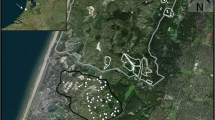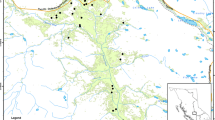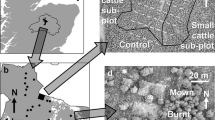Abstract.
Both bison and prairie dogs have multiple and dramatic effects on grassland landscapes and both are considered by many to be keystone herbivores. Numerous studies have documented their independent or combined impact on grassland ecosystem processes, but there have been few attempts to simultaneously assess the individual and interactive effects of bison and prairie dogs where they co-occur. We began a long-term study in late 1994 in Badlands National Park, South Dakota, USA, to evaluate the ecological consequences of the presence or exclusion of prairie dogs, bison, or both, upon various aspects of plant community dynamics and N cycling. Five different treatments were established at three separate mixed-grass prairie sites in the park: (1) off the prairie dog colony with bison excluded, (2) off colony with continued bison utilization, (3) on colony with bison excluded but continued prairie dog use, (4) on colony with utilization by prairie dogs and bison, and (5) on colony with both excluded. There were few differences in aboveground biomass or plant species composition between the two off-colony treatments or among the three on-colony treatments, even after 3 years of treatment imposition. However, aboveground biomass was >2 times greater in off-colony sites than on-colony sites, primarily due to the near elimination of grasses on prairie dog colonies. Off-colony sites were dominated by a few grass species, resulting in lower plant species diversity, while on-colony sites were dominated by several forb species. Net N mineralization early in the growing season was 4 times greater on prairie dog colonies than at off-colony sites, but all sites exhibited net immobilization by the latter half of the growing season. The results of this study indicate distinct differences in several ecosystem properties between on- and off-colony treatments. Whether these patterns represent relatively stable alternate states or whether distinct changes will emerge in the different herbivore treatments after several additional years is of considerable interest.
Similar content being viewed by others
Author information
Authors and Affiliations
Corresponding author
Additional information
Electronic Publication
Rights and permissions
About this article
Cite this article
Fahnestock, J.T., Detling, J.K. Bison-prairie dog-plant interactions in a North American mixed-grass prairie. Oecologia 132, 86–95 (2002). https://doi.org/10.1007/s00442-002-0930-8
Received:
Accepted:
Published:
Issue Date:
DOI: https://doi.org/10.1007/s00442-002-0930-8




